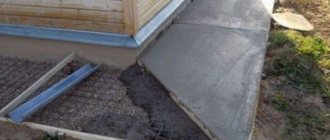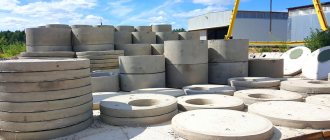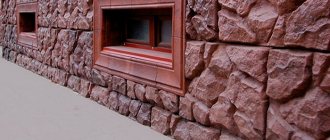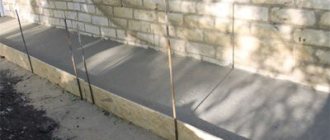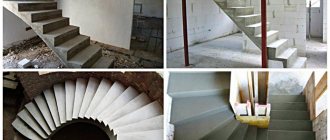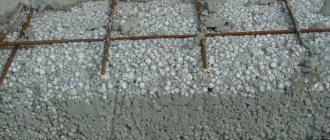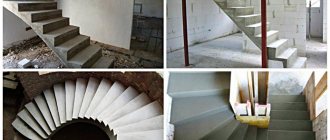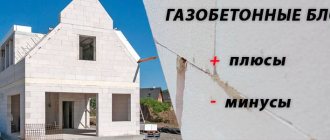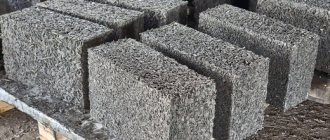To create a source of drinking water, it is not enough to choose a good place, dig a mine and strengthen it. Around the top part it is necessary to lay a layer that does not allow groundwater to pass through. A clay castle for a well made of concrete rings is built taking into account the features that affect its functionality.
A clay castle is needed to prevent groundwater from leaking through.
What it is
A clay well lock is a layer of compacted clay that is placed along the concrete rings of a water shaft to prevent rain or waste water from entering. It is actually a water seal.
Advantages and disadvantages
The advantages include:
- Reliable and effective waterproofing material. It is not for nothing that at the depth where the clay layer lies, there is practically no groundwater.
- Very low cost.
- You can build it yourself.
- Simplicity of design.
- If constructed correctly, the structure will last a long time; it will not have to be repaired or maintained.
However, there are some disadvantages:
- The installation process is quite labor-intensive and long.
- Not every clay is suitable for the shutter.
- If it has not dried properly, then during frosts it will swell and cracks will form.
- If compacted poorly, the material tends to shrink, which will lead to the formation of a hole around the shaft.
A little about accessible aquifers
Diagram: occurrence of aquifers
- Verkhovodka. It is located closest to the surface and is replenished due to precipitation, which is why its fullness is constantly changing, and during dry periods and in winter it can disappear completely. In addition, it is susceptible to pollution by wastewater treatment plants.
- Ground. They lie at a depth of 6-20 m and are located between two waterproof layers, but do not have excess pressure, so the water level in the well shaft remains practically unchanged. Only minor changes are observed at different times of the year.
- Artesian waters are located at a considerable depth, are strongly squeezed between two waterproof layers, which is why they are under pressure, and when the formation is pierced, they gush out to the surface. The quality of the water is beyond doubt, but the construction and maintenance of a well of a special design is usually not cost-effective.
When and why do you need such a device?
A clay castle around the well is needed if there is a risk of swampiness or an abundance of perched water on the land plot in the spring and autumn.
To prevent the aquifer from concrete rings from becoming clogged with soil and debris carried by rain, as well as the upper layers of groundwater, it is not enough to hermetically seal the seams between the rings. It is necessary to provide additional waterproofing.
Disadvantages of a clay castle
The poor quality of the work performed is due to the fact that people who decided to lay the clay castle themselves do not adhere to the technology.
If the clay is not matured enough, is not mixed correctly, is dry or uneven, it is impossible to achieve the desired plasticity. People do the backfill as is and simply compact it with a mechanical tamper.
As a result, the perched water, which lies in the upper layers of the soil, freezes in winter. The resulting ice, when expanding, puts excess pressure on the rings and seam and leads to a violation of the integrity of the structure. Another drawback is the two-year wait for natural soil settlement. But this problem can be solved with a temporary castle made of compacted sand.
What clay is suitable
Not every one is suitable for the shutter. You need to select raw materials according to several parameters:
- It must be very fat.
- It cannot contain sand or lime.
- Looks like plasticine.
- If you rub it, there will be no grains of sand on your palms. The piece will remain a single mass.
The best way to check the composition of the raw material is to mold it into a ball and leave it in the sun to dry. The oily one will crack and become tough. The ball containing sand and impurities will remain unchanged, and grains of sand will shine on its surface.
How to improve
- Soak in water for several days. This measure will allow it to gain a sufficient amount of moisture and become more pliable for work.
- Soak in water, but leave it outside for the whole winter. After it sits in the cold and then thaws, the clay will become like real plasticine.
- Add slaked lime to the raw clay in a ratio of 20% to 100%.
Details
Nuances when installing a soft blind area
You can hear the opinion that the soft blind area is a relic of the past. This is done in two cases:
1.builders strive to deliver the finished well faster; they don’t want to wait until two years are up to build a castle out of clay.
2.because of the benefits. Builders need to be constantly contacted for well cleaning services, because the garbage will be collected faster.
When laying a soft blind area, you need to take into account some installation features. Among them are:
1. the construction of the castle begins with the second ring.
2. The materials you will need are a waterproofing film with sand.
3. Along the edges, the film is placed over concrete rings.
4. Material serving for decorative purposes is laid on top of the film with sand.
DIY clay castle installation
Before installing the clay castle, the soil is dug up to the second ring. The spent soil is no longer used and should be removed from the site. A film is placed on the bottom. The area on which the film is laid should be at least a meter from the outer wall of the well.
On one side, the film is placed over the seam of the well. The edges are secured with a metal belt using self-tapping screws and tape. Self-tapping screws must be screwed into concrete rings. If you use tape, then wrap the material in several layers. Sand is poured on top of the film. You should not fill it to the top so that there is enough space for a decorative coating made of rubble natural stone, or FEM. When laying the material, it is necessary to leave an angle of inclination in the direction from the well of at least one or one and a half degrees. This method is used temporarily in order to make the structure airtight. Not all types of clay are suitable for a castle.
How to choose clay
To make a clay castle, choose red clay with a greasy consistency.
The clay composition should not contain more than 15 percent sand impurities. The clay may not be completely clean, but it is best not to exceed the permissible limit of solid particles that do not bind the material. Attention! The clay should be cleaned of stones and any kind of contaminants.
If a fatty clay is not available, another type of clay can be used. Before using it, the material must be soaked and aged. The clay is soaked in the fall, and laying begins in the winter. We must ensure that the clay does not dry out, that it remains plastic and does not crumble.
When the material is soaked, it can be frozen and then thawed. This is beneficial, the entire material is saturated with water. It is important that the mass does not dry out or crack. To impart plasticity to the material, lime is added at a rate of 1 to 5. For one dose of lime there are 5 doses of clay.
Disadvantages of a clay structure
In order for the lock to perform its functions, you need to adhere to technology during its installation. The clay must be kept for the required amount of time, kneaded in accordance with the proportions, it must be of a homogeneous, not dry consistency, so that there is plasticity. If you simply perform mechanical compaction after filling the well with clay, then this is not enough.
During frosts, the upper layers of soil containing perched water will freeze. The ice formed in the structure expands, pressing on the joints and rings, destroying the well. Another main disadvantage of a clay castle is the waiting time of 2 years for the ground to settle. However, this drawback can be eliminated by making a temporary castle using sand.
How to do it yourself
After the well is installed, you can begin backfilling with soil. You can't bury it completely. It is necessary to leave the top two rings unburied, this is approximately 180 cm from the top level of the ground to the bottom of the castle. If the source is already buried, then you will have to dig a trench around it 180-200 cm deep and at least 20 cm wide.
Now you can start forming layers. The shutter is laid in stages, 20-30 cm at a time. Each layer is compacted with a special tool. It is not enough to simply trample it with your feet, as air will remain in it, which will then fill with water. For compaction, a homemade wedge-baba is used - this is a wide log approximately 150 cm in height and 25-30 cm in diameter with handles attached at the top.
The clay castle consists of two parts:
- The inner part is clay adjacent directly to the concrete ring, on the other side pressed by a soil dump.
- The outer (visible) part is located at ground level, rising 20-30 cm above the ground. Also, we must not forget about the slope from the well to the side. This is necessary so that water flows outside the castle during rain.
In areas with harsh climates and sudden temperature changes, the high moisture content of the valve may freeze, causing it to swell, crack, and begin to expand, pushing the shaft rings inside the barrel, displacing the joints.
Subsequently, no matter how sealed the source is, soil and high water will begin to penetrate into it, which, in turn, will lead to a deterioration in water quality. To prevent this from happening, you need to add a compression layer.
Safety Basics
Inexperienced homeowners often neglect basic rules and endanger not only themselves, but also their partners. To avoid ridiculous injuries, you need to follow at least some basic rules.
- A person in a mine must protect his head with a helmet. Anything can happen; a bucket falling down or a tool falling down is not uncommon.
- Ropes, ropes, ropes, rings - everything related to lifting is carefully checked before starting work.
- A person dripping in a shaft must be secured with a rope, and if the depth of the well is over 6 m, then with two: a working rope and a safety rope.
The construction of a well must be carried out by several people
- There are so-called gas pockets in the soil, and since the air exchange in the mine is not fast, as you descend, they periodically light a candle. Its flame should burn evenly, which indicates a sufficient amount of oxygen; if the fire goes out, the pit needs to be checked.
Advice! There are several ways to ventilate a mine. The easiest way to do this is with a thick blanket, which is lowered to the bottom several times and raised back on ropes. A fan lowered to the bottom of the shaft will also help speed up gas exchange.
Groundwater repair and restoration
Sometimes, if installed incorrectly, as a result of long-term use, the valve becomes unusable, and dirty water begins to penetrate into the shaft.
If during the inspection it turns out that the water seal is not working, then it can be repaired. When the upper part of the lock has peeled off and a gap has appeared between the clay and the ring, as well as in the ground, it means that the well has shrunk, and you can get by with repairing the upper part. To do this, you need to dig out and remove the clay to a compacted area. Compact the layer again and add the required amount again. For repairs, it is better to use new clay, fatter than before.
If it is clear in the shaft that groundwater is flowing through the butt joints, then the entire castle must be repaired. Here you will have to do everything again. Completely remove the clay from the trench and fill it with new clay. Of course, you can try to use the old one, but in this case it needs to be thoroughly processed (soaked in water, mixed with slaked lime).
Conclusion + useful video
Summarizing all of the above, we determine that all the work associated with the installation of a clay castle can be done independently. Teams that claim that this is not necessary cannot be considered professional, or are being cunning in front of the customer. The described procedure is one of the mandatory measures for the improvement of natural drinking water sources.
The only thing that needs to be taken into account is that the clay castle is installed two years after the well is put into operation.
This means that in some cases decoration will have to be postponed. And within a two-year period, sand will be installed instead of clay. Otherwise, there are no difficulties, and the water in the well will remain clean and clear for years.
What is a blind area: what types are there?
After installing the water seal, the issue of draining storm water from the mine shaft remains open.
A blind area is a structure around a well, equipped with a slope from the ring to the side. It comes in hard and soft material.
Solid:
- clay;
- concrete.
Soft:
- special waterproofing film;
- bikrost, roofing felt;
- high density polyethylene film.
Pros and cons of soft and hard
There is a fundamental difference between soft and hard. The second one looks like a slab, the first one, on the contrary, is not visible at all.
Concrete and clay have a structure that can swell when frozen.
Soft, on the contrary, does not deform.
Also, when the earth shrinks around the well, the solid blind area will not sag, and a gap will form between the concrete and the ground, which will not be immediately visible. Over time, water and soil will get into it. If a ring gets into the barrel, it can ruin the quality of the water.
Common errors
- When building a foundation, basement, cellar or well, it is not always possible to obtain clay (loams) suitable for constructing a clay castle. In this case, the material needs to be purchased, so in order to reduce the cost of construction for a clay castle, they use everything that remains in the soil dump;
- The clay poured into the castle is not crushed or compacted, but simply compacted with feet or a tamper (a piece of log with handles). With this technology, the structure of the clay does not change and it cannot become a reliable waterproof barrier. Clay must be kneaded - in the old days it was kneaded with feet;
- During construction, the dimensions (volumes) of the clay castle are not maintained. They are made significantly less than required, so the clay castle turns into a blind area made of clay.
.
Sources
- https://GidroGuide.ru/material/glina-dlya-gidroizolyacii.html
- https://7dach.ru/NatashaPetrova/nekotorye-zabluzhdeniya-zhelayuschih-imet-kolodec-ustroystvo-glinyanogo-zamka-153718.html
- https://RuFundament.ru/zashhita/glinyanyj-zamok-vokrug-fundamenta.html
- https://podomostroim.ru/kak-svoimi-rukami-postroit-pogreb-glinyanye-smazki-i-glinyanyj-zamok/
Tips for use
- It is not advisable to equip them immediately after installing the well. It is better to let the soil settle for a year or more.
- When installing a soft blind area, it is better to use special waterproofing films.
- It is better to make a castle and blind area in late spring, when there are no longer frosts and the soil is still filled with water. In addition, during the spring and summer it will be clear whether the work was carried out correctly and whether it copes with water.
- The slope angle for a solid blind area is 2-5 degrees. For soft - 5-10.
- To install a concrete blind area, it is better to assemble wooden or metal formwork, and not just pour raw materials into a dug ditch. This will help give shape and neatness to the final product.
- After arranging the concrete blind area, you can build any decorative structure on the surface, for example, a gazebo with a roof.
Waterproofing materials
Internal and external waterproofing of the well is carried out:
- membrane and roll building materials;
- two-component compositions;
- coating preparations;
- mixtures based on astringent minerals;
- bitumen-polymer mastics.
The choice of building material depends on the sealing method, financial capabilities and time of waterproofing - it occurs at the stage of constructing the well or after. A set of tools is also selected based on this principle.
Ensuring protection of well rings from displacement
In order to prevent any movement of the deck rings, it is necessary to install additional fasteners. To install additional fastening, you will need plates that are not subject to corrosion, as well as fasteners that are fixed in the supporting base and hold any structure (anchor bolts).
Stainless steel plates must be installed from the surface of the soil. It is necessary to complete the installation when you reach a height that is two hundred millimeters below the second seam.
The best option for this work is to use non-woven plastic materials, as they do not rot.
Drainage system for the site
Good waterproofing will cope with a temporary increase in groundwater level, but if it is consistently high in winter and summer, you will have to come up with a larger-scale solution. For example, drainage that will remove excess moisture. The drainage system will cope with abundant surface water after rainfall and snowmelt. Moisture is collected in channels and discharged into a special well, pond or sewer. The same technology is used to drain groundwater from the foundations of buildings.
In some cases, an additional well to collect excess moisture helps solve the problem of seasonal flooding of a drinking well with groundwater. It can be pumped out and used for technical purposes. To protect wells, caissons and conductors are installed at the depth of the waterproof layer. Active substances dissolved in groundwater accelerate metal corrosion processes.
Selection of the optimal hydraulic seal
Industrial or home-made waterproofing seals are a simple way to eliminate pressure or non-pressure leaks in a well. The technology for using hydroseals is very simple; even a non-specialist can waterproof a concrete well.
When choosing a method for eliminating a leak, pay attention to its characteristics: we recommend eliminating pressure leaks using ready-made, quick-hardening hydraulic seals.
You can eliminate non-pressure leaks, as well as waterproof the seams inside the well, using self-made hydraulic seals. The use of homemade hydraulic seals is only possible in a dry well, because... the available water will wash the solution before it hardens.
The list of well maintenance activities includes not only repairs. Much more often it is necessary to clean the well shaft, the methods and features of which are described in detail in the article we propose.


